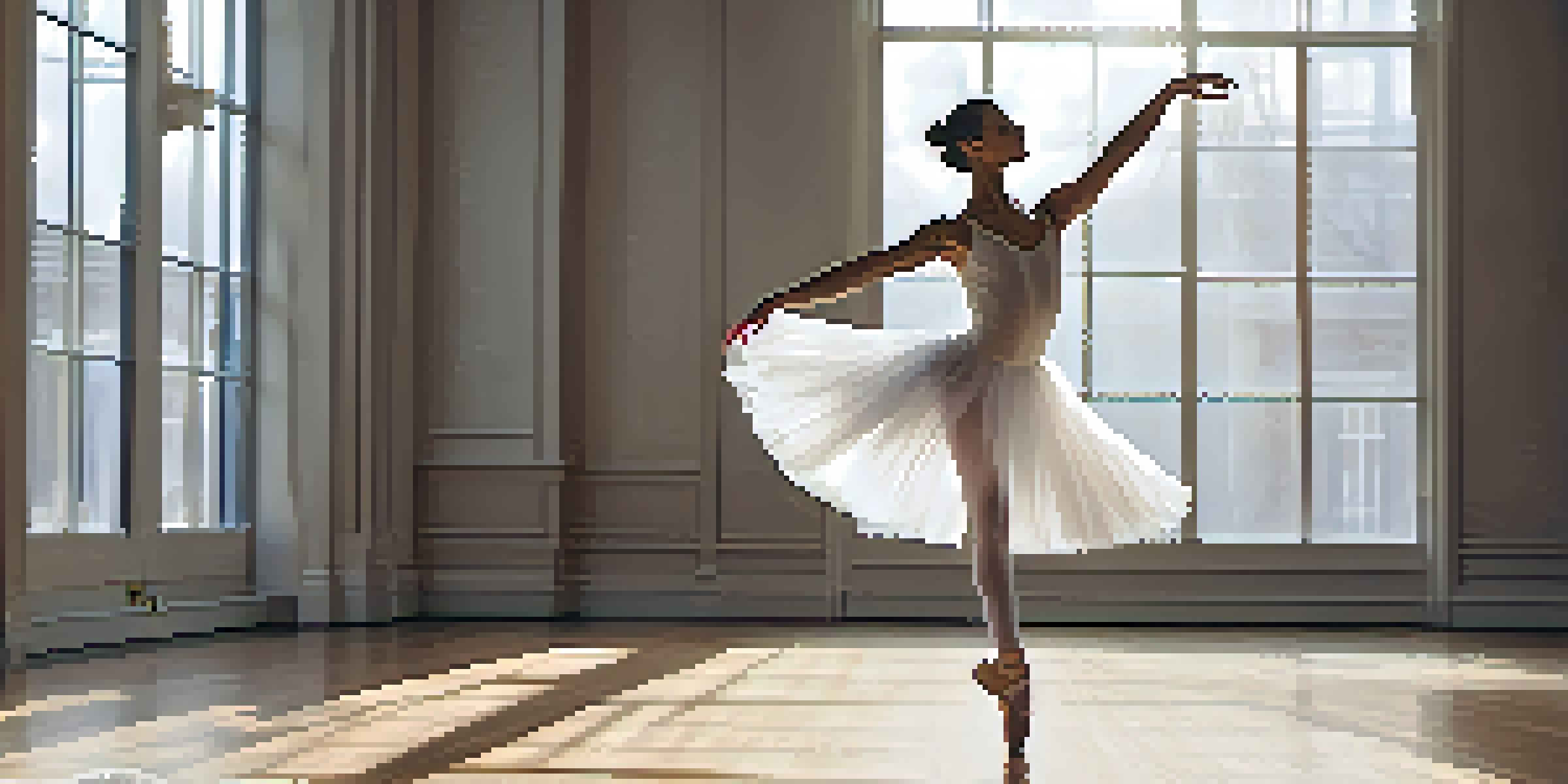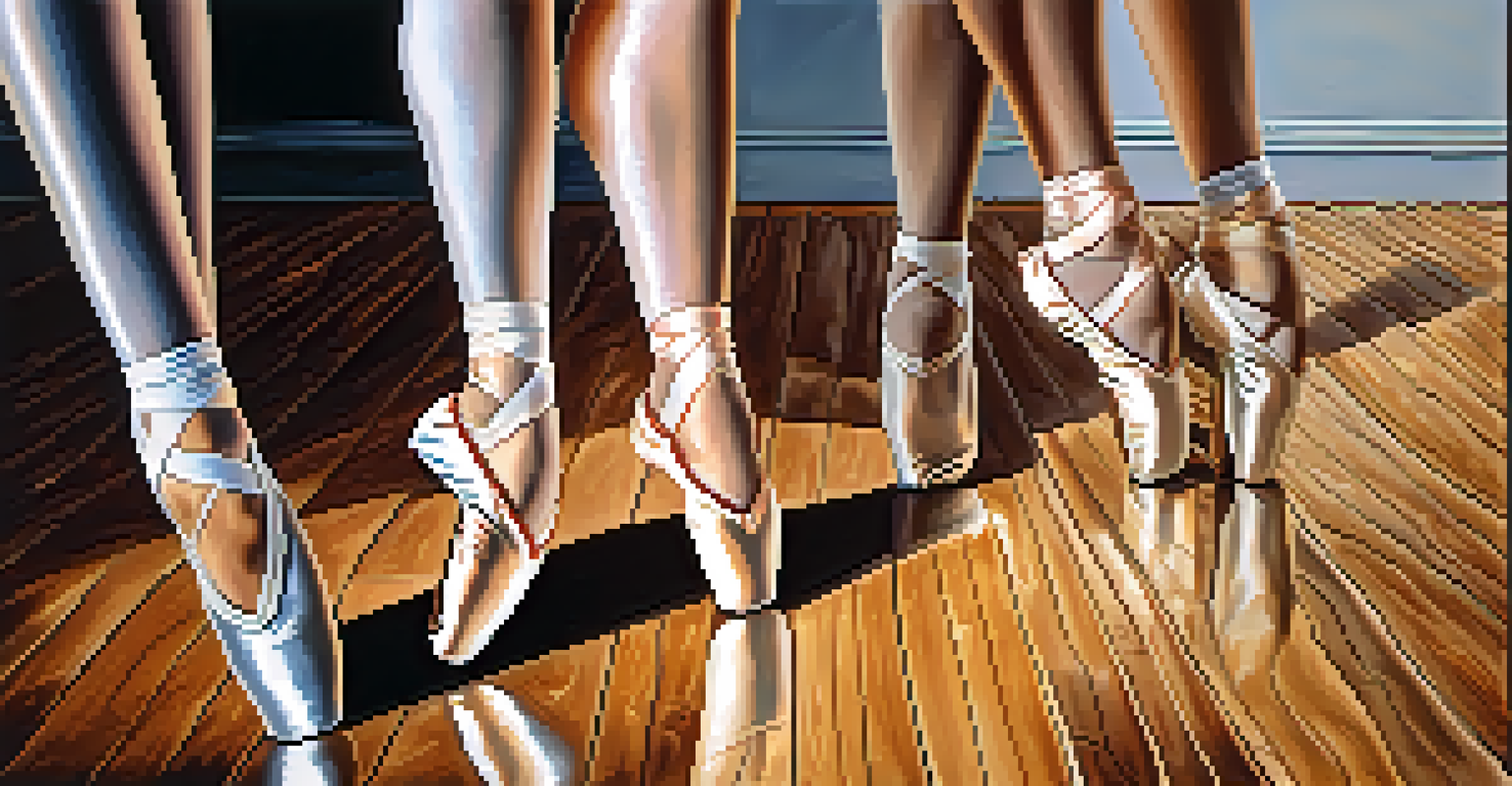Understanding Ballet Techniques: A Comprehensive Overview

The Foundations of Ballet: Key Elements Explained
Ballet is a dance form that combines grace, precision, and athleticism. At its core, it is built on a foundation of key elements such as posture, alignment, and technique. These fundamental components not only enhance a dancer's performance but also help prevent injuries.
Ballet is like a dream, and every dancer is a storyteller who brings that dream to life.
Understanding the importance of technique is essential for both beginners and seasoned dancers. Proper alignment allows for more fluid movements, while strong posture contributes to the overall aesthetic of the dance. These basics serve as the building blocks for more advanced ballet techniques.
Just like learning to ride a bike, mastering these foundational skills takes practice and patience. With consistent training, dancers can develop muscle memory, making it easier to execute more complex movements as they progress.
The Five Positions of the Feet: A Ballet Essential
In ballet, the feet play a crucial role, and the five positions serve as the starting point for many movements. These positions—first, second, third, fourth, and fifth—are essential for balance and technique. Each position has its own unique characteristics and applications.

For instance, first position involves the heels touching and toes pointing outward, creating a stable base for various movements. As dancers progress to second position, the feet move apart, enabling a wider stance that allows for greater mobility and balance.
Ballet's Core Elements Matter
Key elements like posture, alignment, and technique form the foundation of ballet, enhancing performance and preventing injuries.
Mastering these positions is akin to learning the basic chords on a guitar; once you grasp them, you can create beautiful music—or in this case, stunning dance performances. Each position lays the groundwork for more intricate steps and combinations.
Understanding Ballet Turns: Techniques and Tips
Turns are an exciting and dynamic aspect of ballet that showcase a dancer's control and fluidity. Whether executing a pirouette, fouetté, or chaine, understanding the mechanics behind these spins is vital for success. Proper technique can make all the difference in executing these movements flawlessly.
Dance is the hidden language of the soul.
The key to a successful turn often lies in the preparation. Dancers must focus on their core strength and spotting—a technique where the dancer focuses on a fixed point to maintain balance and avoid dizziness. This not only enhances performance but also helps in achieving greater precision.
Think of turns like a well-rehearsed story; every element must come together seamlessly to captivate the audience. With practice, dancers can perfect their turns, adding elegance and flair to their performances.
Leaps in Ballet: Height and Grace Combined
Leaps in ballet are breathtaking moments that combine strength, technique, and artistry. From grand jetés to assemblés, each leap tells a story and elevates the performance to new heights. Understanding the mechanics of these jumps is essential for achieving both height and grace.
To perform a leap successfully, dancers must focus on their take-off and landing. A strong plié (bending of the knees) provides the necessary power for take-off, while a controlled landing ensures safety and poise. The fluidity of movement is what makes leaps so visually stunning.
Mastering Ballet Positions is Key
The five positions of the feet are essential for balance and technique, serving as the starting point for many ballet movements.
Imagine a bird taking flight; the grace and power involved in a leap evoke similar imagery. With dedication and practice, dancers can master these aerial movements, leaving audiences in awe.
Ballet Styles: Exploring the Different Techniques
Ballet is not a monolithic art form; it encompasses various styles, each with its unique techniques and characteristics. From classical ballet, known for its stringent techniques, to contemporary ballet, which embraces innovation, there is a style for every dancer. Understanding these differences can help dancers find their niche.
For instance, the athleticism of neoclassical ballet emphasizes speed and strength, while romantic ballet focuses on emotion and storytelling through movement. Each style requires a different approach to technique, allowing dancers to express themselves in diverse ways.
Think of ballet styles as different flavors of ice cream; each one offers a unique experience. Exploring these styles can enhance a dancer's versatility and broaden their artistic expression, making their performances more dynamic.
The Role of Ballet Training: Building Skills and Confidence
Training is an integral part of a dancer's journey, shaping their skills and building confidence. Regular classes focus on technique, strength, and flexibility, ensuring that dancers develop a well-rounded skill set. This dedication to training is what separates aspiring dancers from seasoned professionals.
Additionally, ballet training fosters discipline and perseverance. Dancers learn to push through challenges, whether it's mastering a difficult routine or overcoming physical limitations. This mental fortitude is invaluable, not just in dance but in life.
Training Builds Skills and Confidence
Regular ballet training fosters discipline and perseverance, shaping dancers’ skills while boosting their confidence for performances.
Consider training as the gym for dancers; it builds strength, endurance, and resilience. With each class, dancers not only refine their skills but also gain the confidence to express themselves on stage.
The Importance of Performance: Bringing Ballet to Life
Performance is where all the training and technique come together, allowing dancers to showcase their hard work and passion. It’s not just about executing steps; it’s about telling a story and connecting with the audience. This aspect of ballet transforms it from a technical skill into a powerful artistic expression.
During performances, dancers must tap into their emotions, conveying the narrative through movement. This connection with the audience is what makes each performance unique and memorable. The energy exchanged between the dancers and the audience can create an electrifying atmosphere.

Think of a performance as a well-crafted novel; every movement contributes to the overall narrative. By embracing the artistry of ballet, dancers can leave a lasting impression, turning a technical showcase into a heartfelt experience.
The Future of Ballet: Evolution and Innovation
As with any art form, ballet continues to evolve, incorporating new ideas and techniques. Contemporary influences are reshaping traditional ballet, blending it with other dance styles and artistic expressions. This evolution keeps ballet relevant and exciting for new generations of dancers and audiences.
Choreographers are experimenting with movement, pushing boundaries and challenging the norms of classical ballet. This innovation opens up new opportunities for dancers, allowing them to explore different styles and techniques while remaining rooted in ballet’s rich tradition.
Imagine ballet as a river; it flows and changes with time, carving new paths while retaining its essence. The future of ballet is bright, promising a dynamic landscape where tradition and innovation coexist beautifully.